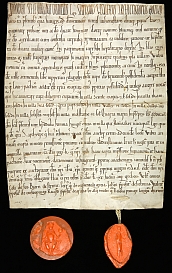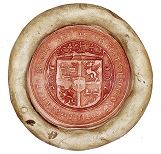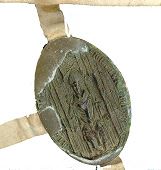The contents of the medieval charters are usually legal in nature. Wills, deeds, purchase contracts and other documents proving the valid ownership of land and farms were important to preserve. The charters mention many people (issuers, addressees, witnesses, etc.) and locations (issuing places or names of towns, farms and parishes where property transactions were made). There are only a few private letters preserved.
A Diplomatarium is a (printed or unprinted) collection of diplomas.
How many charters have been preserved?
There are more than 20,000 original charters preserved from the Swedish Middle Ages. Many originals have disappeared for various reasons, but sometimes transcripts had been made before that. Overall, we know about 44,000 Swedish medieval charter texts. The vast majority of the originals and transcriptions are today at the National Archives in Stockholm.
 How old are the charters?
How old are the charters?
The oldest Swedish preserved original charter dates from the mid 1160s (pictured here). At the National Archives there is also an original charter from Skåne (Denmark), issued in the 1130s, and even older fragments of discarded parchment manuscripts.
What language was used?
Until the mid 1300s, Latin was used in all the charter texts. At this time, Old Swedish gradually became the main charter language. In international correspondence and within the church, Latin was used throughout the Middle Ages.
What writing material was used?
Most of the preserved originals were written on parchment. Not until the mid 1300s do we find paper used for certain types of charters and letters.
Seals

 The seals (wax) were made by means of a metal punch. Seals – not signatures – made charters valid. Secular people most often used round seals. The clergy and monasteries mostly used oval seals.
The seals (wax) were made by means of a metal punch. Seals – not signatures – made charters valid. Secular people most often used round seals. The clergy and monasteries mostly used oval seals.
Seals were appended on the lower edge of the parchment, and sometimes they were placed in protective pouches. On paper charters the seals were generally impressed on the reverse side. Many seals have been destroyed or disappeared from the preserved original, but a relatively large number still remain.
The seal usually shows a person’s arms or the owner’s mark. Around the edge there is a text displaying the person’s name and sometimes office.
